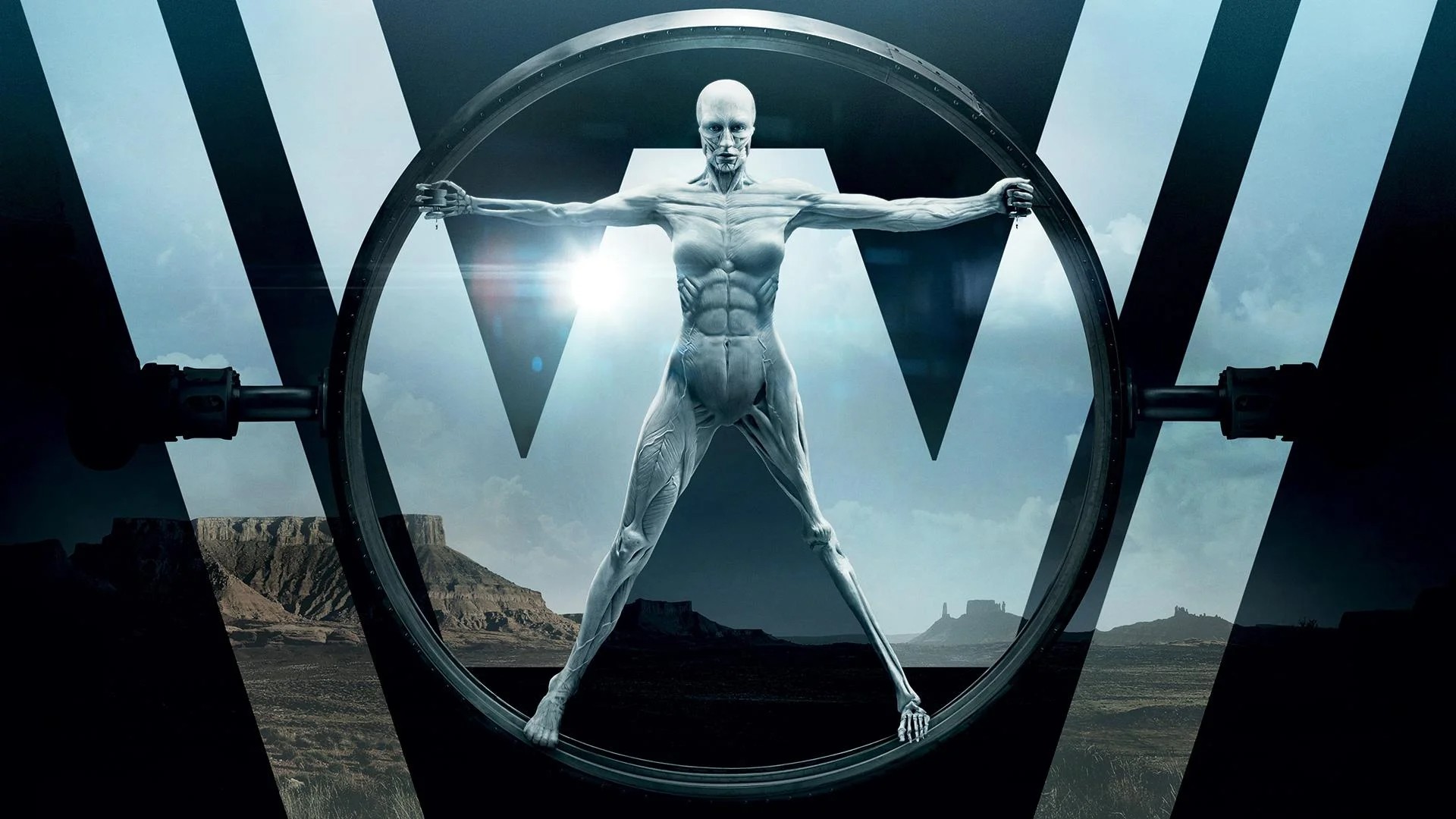Core Data:
- Vision: totally immersive theme parks populated with robot ‘Hosts’
- Type: Popular culture – TV
- As Seen In: Westworld
- Envisioned: 2016 present
- Visionary: Jonathan Nolan and Lisa Joy (creators/showrunners); Michael Crichton (writer/director of original movie)
- Target Date: Early 2020s (for the first iterations of the park)
Overview:
Before all those dinosaurs ran amok on Isla Nublar, Jurassic Park author Michael Crichton opened the doors to another theme park with serious safety issues. His 1973 Westworld movie featured The Magnificent Seven hero Yul Brynner turning to the dark side as a murderous robot gunslinger, and HBO’s big-budget TV remake riffs on similar themes.
There’s a lot more to Westworld 2.0 than a trigger-happy man in black bumping off the clientele, however. Creators Jonathan Nolan (The Dark Knight, Person of Interest) and Lisa Joy (Reminiscence) instead use the premise to craft a labyrinthine mystery box of a show. And in this multi-layered, often confusing update, big philosophical questions about the nature of self are as integral to the storytelling as sophisticated robots turning on their masters.
As the android Hosts in the eponymous theme park gradually gain sentience, they find themselves in a shades-of-grey world, where everybody – human and machine – seems to be following an agenda of their own. But how plausible is the tech that makes Westworld tick?

Key Tenets:
- Hardware: The Westworld theme park is around 500 square miles in area, situated in an unspecified area of the United States. The site contains a mix of the towns, plains, mines and farms you’d expect to find in a Hollywood Western.
- The theme park’s main attraction is its robot “Hosts” who, despite being artificial, are almost indistinguishable from humans. There are also synthetic animals – such as horses – to add to the immersive experience.
- The park is operated out of the Mesa Hub, a vast building containing control rooms, maintenance facilities and guest hospitality – as well as the Cradle (CR4-DL), the giant server farm that stores the data and complex software that control the Hosts.
- Although early Host models were mechanical, technology has evolved to the point where their muscular and skeletal systems are much closer to those of a human.
- Host brains consist of a spherical data storage module inserted in the skull. As well as controlling the Host’s functions, they can be used to collect guest data, such as video, audio and samples of their DNA. These memories do not degrade over time.
- Each Host is programmed with its own unique personality. While the AI are designed to respond to human guests in a convincing manner, they’re all working through a finite number of pre-programmed storylines known as “narratives”. These are regularly reset when a guest has completed an arc (known as a “loop”) with a particular Host.
- Maintenance can be performed via wireless updates, a hard wire connection (effectively an in-built USB port) or by direct contact with a human engineer. This can involve physical repairs to a unit that’s been damaged in the course of the Westworld simulation, while software issues can be addressed using the Analysis mode. When this is activated, the Host’s personality is temporarily turned off, and they are required to give accurate responses to the operative’s question. It’s much like running a diagnostic on a computer.
- In theory, Hosts should be unable to recall events prior to a reset.
- That said, original park creators Robert Ford and Arnold Weber introduced software to give Hosts a brief flashback to events from previous loops. In theory, these subliminal memories should make the Hosts more convincing, as they’d integrate more human gestures (or “reveries”) during subsequent loops.
- Standard models of Hosts are unable to leave the park thanks to small explosive built into their vertebrae. If they step outside Westworld’s boundaries, the bomb will detonate – they work on a similar principle to the locks built into some supermarket trolleys.
- Later seasons of Westworld also introduce complex virtual reality simulations, indistinguishable from real life.
- The show also features Rehoboam, a super-powerful quantum computer with the capacity to predict – and consequently shape – future events.
- Experience: On arrival at Westworld, guests are invited to choose their own bespoke wardrobe to wear on the park. Once you’ve booked the dates of your visit, park staff will sort everything else for you.
- Your choice of hat is surprisingly important. A white hat tells other guests you want to be a good guy, while a black hat marks you out as a villain.
- Like the Hosts, each guest has a narrative they can play out in Westworld. The way their story evolves will be dependent on their choices and actions.
- Guests interact with Hosts – and other guests – as if they’re in the Wild West.
- There are no rules for guests. The park sells itself on giving them the opportunity to do or say anything they want without consequence. Sex, sadism and ultraviolence generally feature prominently on the menu.
- There are, however, safety features built in to keep guests safe. While a guest can shoot a Host dead (to be resurrected later, of course), a bullet from a Host should leave a human unharmed. The Hosts also have an in-built “Good Samaritan” reflex to protect paying customers.
- Hosts are not officially designed to be self-aware, but as they learn more and more about previous loops, their programming starts to evolve. When will scientists in movies and TV shows learn…?
- Memories of mistreatment by human guests prompts some Hosts – led by original Host Dolores Abernathy – to start a revolt against their creators.
- A Host’s mind can be transferred between bodies in a way that becomes increasingly confusing as the show goes on.
- Some Hosts believe they’re human. This can also be confusing.
- Hosts can also find their consciousness has been transferred to a virtual reality simulation. And yes, this is often confusing, too.
- There’s more to Westworld than being a state-of-the-art theme park. It’s also a sophisticated data-collection operation, where management routinely collect valuable information about their guests.
- The Rehoboam super-computer uses data from millions of human subjects to model their future behaviour – it can even predict the circumstances of an individual’s death.
- Company:The Westworld theme park is run by Delos Destinations Inc, a subsidiary of vast multinational Delos Incorporated. (The Westworld park in the original 1973 movie was also part of Delos.)
- Westworld and its Host technology were the brainchild of business partners Robert Ford and Arnold Weber. After Weber’s death, Ford created the Host Bernard Lowe in his image, and served as Delos’s Park Director. Ford, a man with something of a god complex, sees Westworld as “not a business venture, not a theme park, but an entire world”.
- The principal shareholder in Delos is Engerraund Serac (aka the richest man in the world), who is also the owner of data analysis company Incite, Inc. He also created Rehoboam.
- IP: Each Host has a unique personality and appearance that is the property of Delos, Inc.
- Other parks under the Delos umbrella include the World War 2-set Warworld and the Japan-set Shōgunworld.
- Economics: Running at a cost of more than $40,000 per day, a trip to Westworld is only for the super-rich.
- And with the site able to accommodate in the region of 1400 guests, Delos are clearly raking it in.

State of Play (July 2022)
- Hardware: As is the case with Blade Runner, Humans, Surrogates and Black Mirror episode ‘Be Right Back’, building a convincing artificial human remains trapped in the domain of science fiction. Real humans are so hardwired to spot a fake that any flaws in skin, eyes or mouth would be instantly obvious – blame the infamous Uncanny Valley – and that’s before you’ve even thought about the technical challenges inherent to creating a lifelike artificial automaton. Right now, getting a machine to walk like a human simply isn’t feasible.
- Genuinely self-aware machines with actual emotions don’t currently exist, but computers are getting better at giving responses that sound like they come from a person. As programming and technology improve, AI should be able to handle more and more complex scenarios.
- Experience: Videogames are already giving us the opportunity to play around in vast virtual playgrounds, where we can interact with virtual people. These experiences may not exist in the physical world, but the experience can still feel immersive.
- The success of games such as Grand Theft Auto suggests that plenty of people have an interest in participating in violent delights – even if their ends aren’t quite as violent as what’s commonplace in Westworld.
- Creating humanoid machines with the capacity for sentience is a questionable move on the part of their creators.
- As soon as they develop self-awareness, forcing them to work in a theme park is slave labour.
- On a purely financial level, this makes no sense. Assuming the law would step in to prevent a business from forcing a sentient Host to work, they’d either have to start paying the machines, or they could walk away.
- More importantly, however, there would be massive, sickening moral implications inherent in exposing a self-aware being to the sort of consequence-free violence-for-fun that comes as standard in the Westworld park.
- Westworld’s clandestine data-gathering operation is straight out of the present day. Everywhere we go online lives a digital footprint, and that data about our behaviour is a valuable commodity in the modern world – particularly for advertisers. Using Hosts to collect information on guests is just a sinister extension of reality.
- Computers can be used to model future events ranging from whether it’ll rain tomorrow to how likely a footballer is to score a goal, but they’re not really predicting the future – it’s more like hedging a bet. Quantum computers (which use quantum states rather than standard bits in their processors) currently lack the sophistication to make complex predictions, but one early example can model 16 possible futures at once.
- Economics: If anyone had the resources and technology to build a totally immersive theme park where anything goes, there would undoubtedly be a clientele. The question is, would there be enough people who could afford the $40,000 per day price tag to make Westworld financially viable?
- Even before you start building and programming the Hosts and putting an infrastructure in place, 500 square miles of real estate is not going to come cheap – even in the middle of nowhere.
Reality check: the data collection themes are more frightening than the robots
A futuristic theme park where machines rebel against their human masters is great for attracting viewers, but the scariest thing about Westworld – at least for now – is a clandestine data gathering operation that’s chillingly plausible.
Further reference:
- Westworld (TV series)
- Westworld (1973 movie)
- Androids
- Android science
- Actroid
- Artificial intelligence
- Uncanny valley
- Affective computing
- Quantum computing
A self-confessed full-time geek, freelance journalist Richard has spent most of his career writing about sci-fi and fantasy – including more than a decade on staff for SFX magazine. He's particularly keen on franchises with "Star" in the title.






































